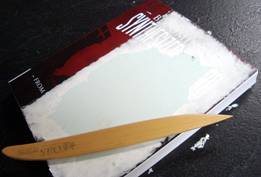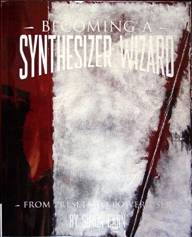 Photo 1
Photo 1
Digital book cover with release paper mounted to it.
The interesting thing about being the mounting queen is that I am supposed to know what to do with digitals. That said I recently did a real number on a new book of my son's. He purchased a music synthesizer along with a series of textbooks to accompany it. One of the books came with its cover badly creased—the lower right cover had been folded back and crunched. Very sad about one of his new books not being pristine he asked Mom if I could flatten it at least. "But of course," she said, "I can't heal broken paper fibers, but I can surely flatten it."
I had been recently flattening original artwork in my press—which I frequently do—so I was afraid my release paper might have a little paint residue on it. Rather than pull new release material for this quickie project I opted to use the back side of the release paper against the book cover since I wasn't mounting it, only flattening it. I slipped the single front cover into the front edge of my 210 mechanical press, release paper face up against the platen, and left it 5 minutes. Yes I did consider this was a digitally printed book with a glossy laminate finish, but never thought much about if it was a laser print or water-based laminate. Long story shorter when I removed the book the paper had fully, FULLY fused to the probable liquid laminate that had been used to coat it. As seen in photo 1 the blue release paper is alive and well and I was only able to peel off a little around the edges.
I refused to bring the book back to my son looking like this—he thought Mom would fix it, not make it worse. So I pulled out my trusty bamboo knife (photo 1)—written up in "PSAs and Burnishers", PFM February 2012 and began to scrape it clean. A mere two hours later I had scraped all the silicone release paper off and thinned out the remaining layer enough to at least read the info through the haze.
 Photo 1
Photo 1
Digital book cover with release paper mounted to it.
Just like many mistakes we try to repair, the book looked much better before I "fixed" it for him. The good news was the cover was indeed flat, the bad news, it was now under a cloud of paper AND the crease still showed. I considered adhesive solvent but thought that might only add insult to injury so we stopped here (photo 2).
 Photo 2
Photo 2
Book after Mom fixed it.
There is a lesson to be learned here. I have taught for years to know what you have before you put it under any heat. I didn't think it through. The book was soft and floppy, I knew it was a quick print digital but I didn't consider it as I would have a piece of "real" art. The bottom line is to never be mindless. Had I put the release paper face down against the laminate it would not have stuck to the coating, but it would no doubt have mottled the surface from the heat, and perhaps clouded the coating. This was only a book, but I shall be certain to think more before putting anything into my press again. And rest assured, if I don't know what it is—it isn't going in.
So much for being Queen.
END
Copyright © 2012 Chris A Paschke
For more articles on mounting basics look under the mounting section in Articles by Subject.
Additional information on all types of mounting is found in:
The Mounting and Laminating Handbook, Second Edition, 2002,
The Mounting And Laminating Handbook, Third Edition, 2008 and
Creative Mounting, Wrapping, And Laminating, 2000 will teach you everything you need to know about getting the most from your dry mount equipment and materials as an innovative frame designer.
All books are available from Designs Ink Publishing through this website.
Chris A Paschke, CPF GCF
Designs Ink
Designs Ink Publishing
785 Tucker Road, Suite G-183
Tehachapi, CA 93561
P 661-821-2188
chris@designsinkart.com